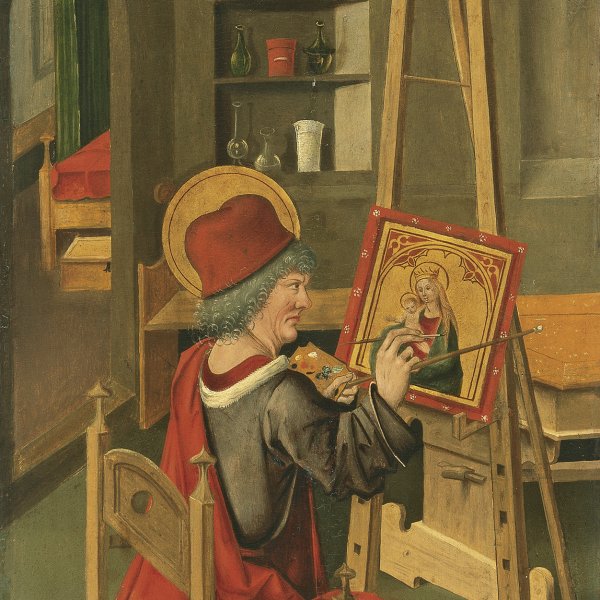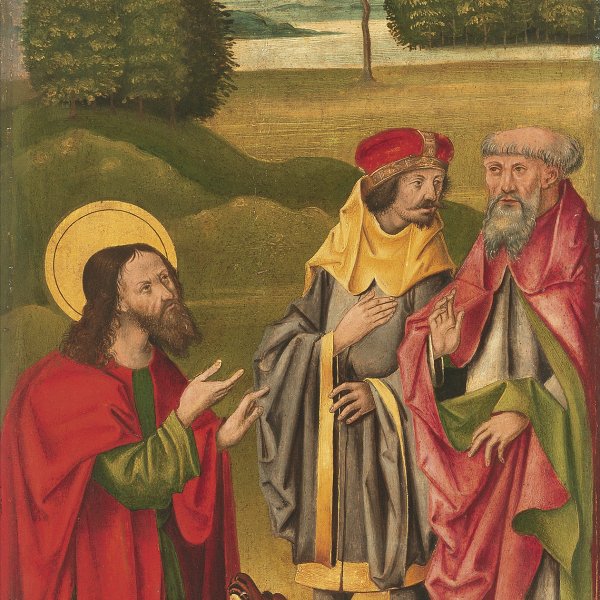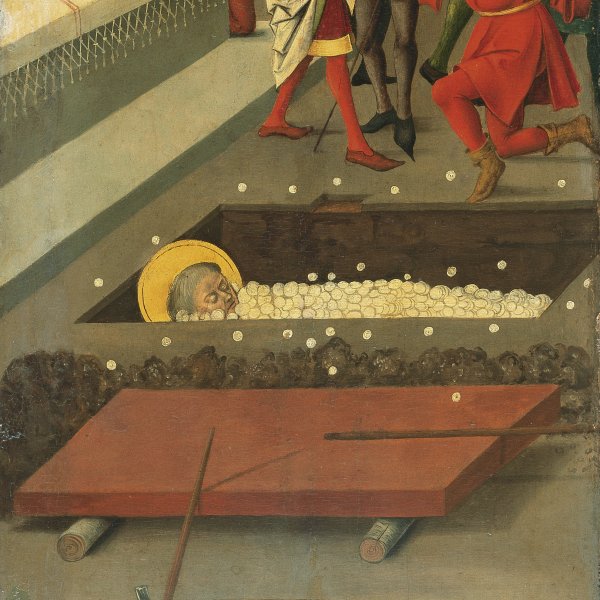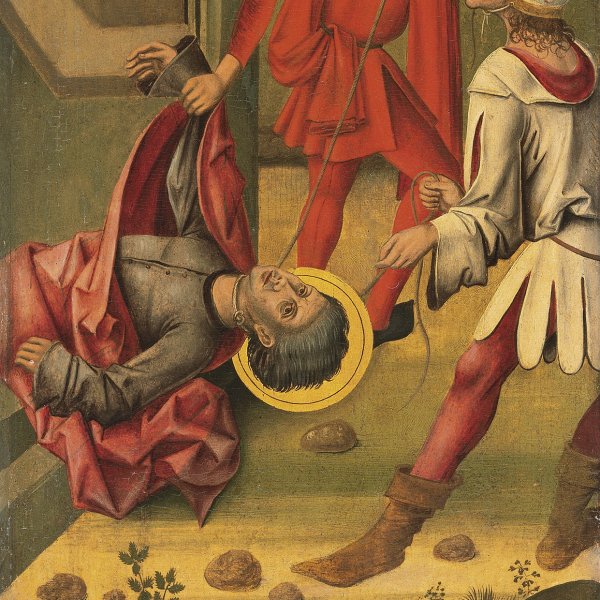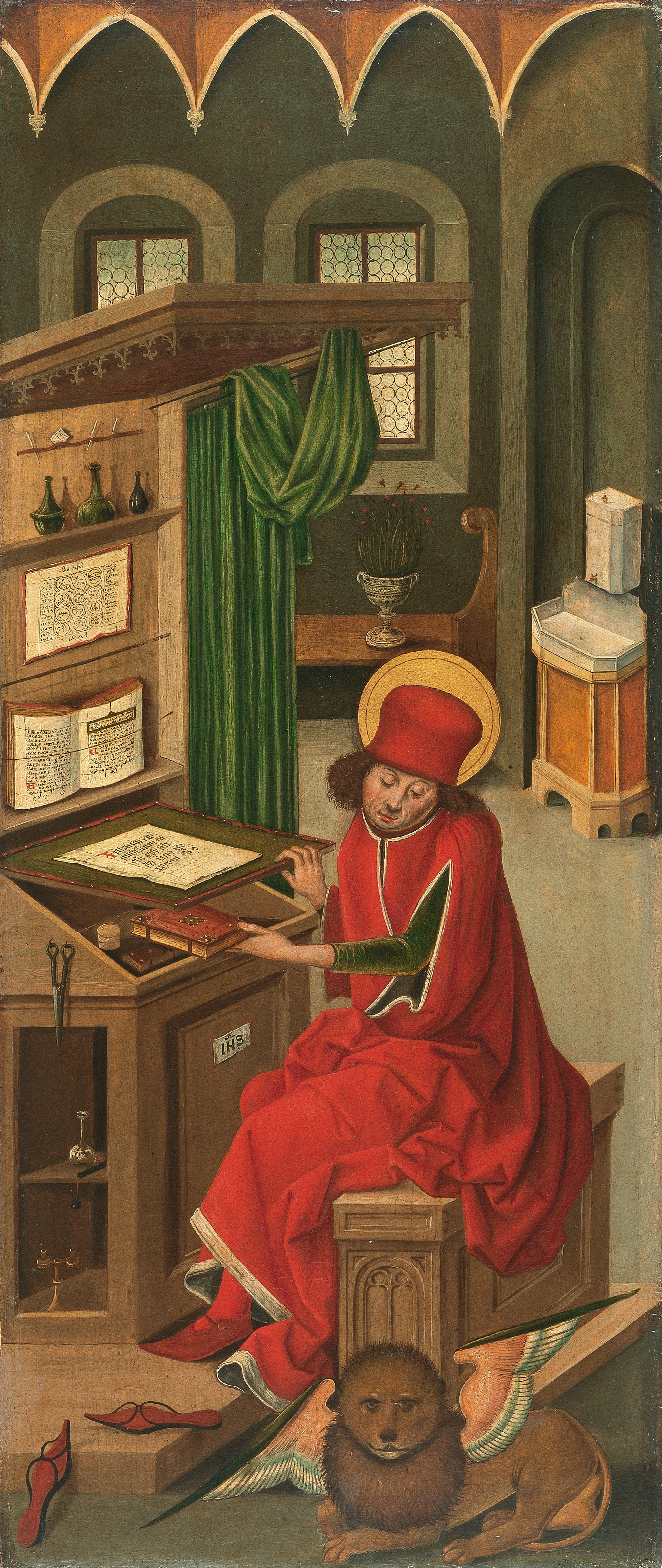Saint Mark the Evangelist
Gabriel Mälesskircher was an important German painter who enjoyed considerable renown in the mid-15th century. A leading member of the Guild of Saint Luke, he worked with Michael Wolgemut, among others. His style reveals the influence of the Munich school although his works are more realistic and imbued with a powerful narrative sense. These eight panels belonged to an altarpiece in the Benedictine monastery of Saint Quirinus in Tegernsee. Mälesskircher produced a number of altarpieces dedicated to the Virgin and various saints and martyrs for this monastery. These particular panels were painted for an altar dedicated to the Four Evangelists, which included depictions of each saint with scenes of his martyrdom and the most celebrated events in his life. They would originally have been accompanied by four more panels, giving a total of twelve. In the first group of four paintings, Mälesskircher depicts the Evangelists working on their Gospels in their studies and with their corresponding attributes. The other four depict scenes from their lives. Saint Luke is shown painting the Virgin; Saint Matthew is taming dragons; Saint John is seen with the miracle of the Hosts while lying in his tomb; and Saint Mark is depicted being martyred, dragged through the streets of Alexandria. The influence of Flemish art is evident in this group of panels, particularly in the importance given to the details.
NR
According to surviving documentation, Mälesskircher painted thirteen large altarpieces and two small ones for the monastery, of which the small ones were intended for a new extension to the monastery’s church. These fifteen altarpieces were dedicated to the Virgin, Saint Quirinus, Saint Benedict, Saint Vitus, martyr saints, virgin saints, Saint John, Saint Paul, All Souls, the Four Doctors of the Church, Saint Sebastian, Saint Martin, the Four Evangelists, the Magi, and the Holy Spirit. All of them were executed between 1473 and 1478. The eight panels in the Museo Thyssen-Bornemisza formed part of the altar dedicated to the Four Evangelists. In the documents relating to this ambitious commission we find precise instructions regarding its contents: the titular saints had to be represented being martyred, as well as shown in various episodes from their life and miracles. It is thought that the original altarpiece of the Four Evangelists comprised twelve paintings. In addition to the eight scenes now in the Museum’s collection, there were two further panels that were in the Voll collection whose present whereabouts are unknown but whose compositions are known from old photographs of The Martyrdom of Saint Matthew and Two Pilgrims before the Tomb of Saint Luke. Finally, the two other episodes were in a private collection in Paris and seem to have depicted scenes from the life of Saints John and Mark. These are also now lost. Like many other religious institutions, the monastery at Tegernsee modernised its decoration over the years and it was redecorated in the Baroque style before it was secularised in 1803.
In the monastery’s records the altarpiece is dated to 1478, a date that also appears on two of the present panels. It can be seen on the inside lid of Saint Matthew’s desk and on the lower edge of the sheet of paper with the zodiac stuck to the front of the Saint Mark’s desk. In the four panels of the Evangelists in their studios, Mälesskircher depicted the four saints working on their Gospels. He used a similar approach to the setting for all the figures, the type of work that they are engaged in and the symbols that identify them. Thus the four are located in highly detailed settings, seated in front of a desk that occupies one side of a room, except in the case of Saint Luke whose desk is in the middle of the room. Mälesskircher depicts them more in the manner of copyists than authors of the Gospels, as two of them (John and Mark) have books above their desktops held open with cords as they work while Saint Mark’s book has a marker indicating his place on the page, suggesting that they are in fact copying the Gospels. In addition to their normal symbols (the bull of Saint Luke, the angel of Saint Matthew, the eagle of Saint John and the lion of Saint Mark), the artist has added lines from their respective Gospels to the pages on which they are working.
The interiors, which are filled with highly decorative details of objects and furniture, are presented as windows through which the spectator looks, allowing the viewer to appreciate the workplace and the implements typical of miniaturists. This world was highly familiar to Mälesskircher due to his early training as a miniaturist. The details that he provides are consequently of great interest, including the placement of the little pots to hold the different coloured inks used for the initial letters (located on right of Saint Luke and Saint John’s desks); the way that Saint Matthew sharpens his quill during a pause in his labours; the industrious efforts of Saint John, who holds implements in both hands; and the tidy interior of Saint Mark’s desk, used to house his instruments.
The rooms in which the Evangelists are located (in which the perspective is not totally correctly resolved) are furnished in the medieval style with lead-framed glass in the windows, shelves housing vessels arranged by size, a few paintings, and basins and jugs for cleaning and washing, indicating the meticulous approach of these craftsmen.
With regard to the paintings that depict scenes from the life of the Evangelists, in the case of Saint Luke, Mälesskircher chose the traditional episode of the saint painting the Virgin (explaining why painters’ guilds were under the protection of this saint and were named after him). Saint Matthew is seen in a landscape background watched by two witnesses as he tames two dragons, which he subdued by making the sign of the cross. The life of Saint John is represented through a posthumous miracle that took place when the saint placed himself in his own tomb, which he had ordered to be dug near the church where he habitually preached. At that moment the grave was filled with a glowing light which, after it was extinguished, was found to have imbued everything with a substance that Mälesskircher interprets as Hosts. The last panel depicts The Martyrdom of Saint Markand depicts the moment when the Evangelist was forcibly removed from a church in Alexandria where he was preaching and was dragged through the streets.
The influence of Flemish art is clear in these eight panels, in which Mälesskircher recreated a sense of daily reality through the rooms, objects and settings. The connection with Flemish art is evident in the technique used to individualise the different elements in the compositions, including the landscapes seen through the windows and the exterior settings in which some of the scenes take place.More specific and important details also suggesting Flemish art include the figures’ clothing and drapery and the concave mirror hanging at the far end of Saint Luke’s studio, reflecting part of the room that could not otherwise be seen.
The panels in the Museum were in the Benedictine monastery at Tegernsee until 1803 then in the Streber collection Bad Tölz. They were acquired as a group from the Hackenbroch gallery in Frankfurt and entered the Thyssen-Bornemisza collection in 1928.
Mar Borobia





